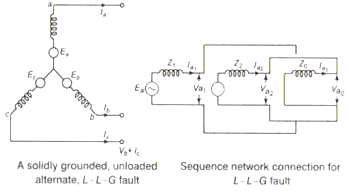Unsymmetrical Fault Analysis | Power Systems - Electrical Engineering (EE) PDF Download
Unsymmetrical Faults (Shunt Fault)
- Single line to ground fault ( LG fault ),
- Line to line fault ( LL fault ) and
- Double line to ground ( LLG fault ) are unsymmetrical faults that may occur at any point in a power system.
To understand the unsymmetrical fault analysis, let us first, consider these faults at the terminals of an unloaded generator. This treatment can be extended to unsymmetrical fault analysis when the fault occurs at any point in a power system.
Consider a three-phase unloaded generator generating the balanced three-phase voltage. The sequence components of the terminal voltages are
1. Single Line to Ground Fault
Ib = 0
Ic = 0
Va = IaZf

(i) Single Line to Ground Fault with Zf
The termination of the three-phase access port as shown in figure brings about a condition of single line to ground fault through a fault impedance Zf .Here, the fault tapes place on phase a.


2. Line to Line Fault
Here, the line to line fault takes place on phases b an C.
Ia = 0
Ib = -Ic
Vb = Vc + Zf Ib
Ib = -Ic = Ia0 + a2Ia1 + aIa2


Fault current


(i) Line to Line Fault with Zf


3. Double Line to Ground Fault
The double line to go and fault takes place on phase b and C as shown in figure below
Ia = 0
Vb = Vc = ( Ib + Ic )Z


(i) Double Line to Ground Fault with Zf


|
30 videos|101 docs|45 tests
|
FAQs on Unsymmetrical Fault Analysis - Power Systems - Electrical Engineering (EE)
| 1. What are unsymmetrical faults in electrical engineering? |  |
| 2. How does an unsymmetrical fault analysis help in electrical engineering? |  |
| 3. What are the main types of unsymmetrical faults? |  |
| 4. How is fault current magnitude determined in unsymmetrical fault analysis? |  |
| 5. What protective devices are used to mitigate unsymmetrical faults? |  |
















